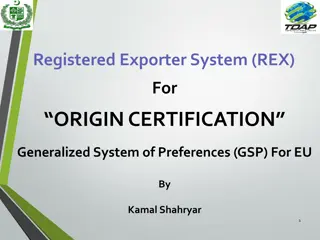Basis of the M/EEG signal
This informative guide delves into the basics of M/EEG signal methods, covering topics such as the biophysical origin of M/EEG, historical background, measurement techniques, and the distinction between EEG and MEG. It explores the history of human EEG, the concept of action potentials, and the prac
0 views • 32 slides
Latin Origin Words with the /s/ Sound Spelled "sc" Activities
Engage students in identifying and exploring words with the /s/ sound spelled "sc," which have Latin origin. This educational material includes teaching activities, independent tasks, and spelling rules to enhance understanding of words like science, ascend, scenery, and more. Students delve into de
3 views • 6 slides
Investment Responses to Biophysical Climate Impacts on Water, Energy, and Land in SDGs and Climate Policies
Investment assessments using Integrated Assessment Models (IAMs) are evolving to include biophysical climate impacts, assessing climate uncertainty on investments. The approach involves the MESSAGEix-GLOBIOM IAM, considering climate policy, SDG measures, and impacts under different scenarios. Climat
6 views • 32 slides
OCEAN FREIGHT INSURANCE | ENSURING SHIPMENT PROTECTION FROM ORIGIN TO DESTINATIO
Ocean freight insurance is vital for protecting shipments from origin to destination, ensuring peace of mind for shippers. This type of insurance covers potential risks such as damage, loss, theft, or delays that can occur during ocean transit. Given the complexities and unpredictability of internat
1 views • 1 slides
Foreign Investment in Large-scale Agriculture in the Lowlands of Ethiopia: Challenges and Paths Forward
This study focuses on the impact of foreign investment in large-scale agriculture in Ethiopia, particularly in the lowlands. It examines the actors involved, biophysical environment issues, displacement concerns, and local community empowerment. The analysis underscores the importance of meaningful
2 views • 6 slides
Understanding Title VI of the Civil Rights Act
Title VI of the Civil Rights Act of 1964 prohibits discrimination on the basis of race, color, or national origin in programs receiving federal financial assistance. This act outlines the obligations of state agencies and recipients of federal funds to ensure equality and non-discrimination. The tra
1 views • 50 slides
The Origin of Viruses: Theories and Evidence
Viruses are acellular parasites with a complex replication mechanism. Studies on their origin present challenges due to the lack of fossils. Three main hypotheses include regressive, cellular origin, and co-evolution. The regressive hypothesis suggests viruses originated from complex ancestors that
2 views • 25 slides
Understanding Rules of Origin and Tariff-Free Trading with the EU
Rules of Origin (RoO) determine the economic nationality of a product, impacting tariffs and restrictions. To trade tariff-free with the EU, compliance with RoO is crucial. Specific rules dictate ingredient sourcing, with certification processes ensuring eligibility for tariff reductions. Certain pr
0 views • 19 slides
Theories on the Origin of State: Divine, Force, Patriarchal, and More
Various theories such as Divine Origin, Force Theory, Patriarchal Theory, and others explain the origin of the state. Divine theories attribute state creation to God, while Force Theory emphasizes the strong subjugating the weak to establish authority. Each theory offers unique perspectives on the h
1 views • 24 slides
Understanding Buy American Act Requirements for Product Origin and Manufacturing
Learn about the key aspects of the Buy American Act, including requirements for specifying the country of product origin and place of manufacture. Discover how to determine exceptions and waivers based on vendor responses. Understand the implications of selecting the place of manufacture for product
0 views • 4 slides
Overview of Registered Exporter System (REX) for Origin Certification under Generalized System of Preferences (GSP) for EU
REX is a self-certification system allowing registered exporters to declare the origin of goods. This system simplifies the process by enabling exporters to issue a Statement on Origin (SOO) themselves. Eligible entities in Pakistan can register under REX, ensuring compliance with EU Customs Regulat
0 views • 26 slides
Theories on the Origin of Earth and Solar System
Scientists and philosophers have proposed various theories regarding the origin of Earth and our solar system, with concepts ranging from evolutionary to catastrophic. The Dust gas cloud theory, Planetesimal hypothesis, Binary star hypothesis, and more have been suggested to explain how planets were
4 views • 7 slides
Understanding Country of Origin Determination by U.S. Customs
The country of origin for exports is a crucial aspect in international trade, especially for goods exported to the U.S. This article delves into how U.S. Customs determines the actual country of origin, the implications of origin fraud, and the warning against illegitimate practices. It sheds light
0 views • 18 slides
Technical Soundness of EU-SADC EPA Rules of Origin
The implementation and technical soundness of Rules of Origin under the EU-SADC EPA are crucial for the utilization of trade preferences. Compliance with rules of origin is essential for receiving tariff preferences, but drafting these rules accurately is challenging. Recommendations include specify
4 views • 12 slides
Overview of Green Gram (Vigna radiata L.): Economic Importance, Origin, and Classification
Green gram, scientifically known as Vigna radiata L., is a highly digestible pulse crop with various uses such as consumption as whole grains or dal, making flour for cakes, and as fodder for cattle. It is grown widely in Southern Asia and other countries, with India being a significant producer. Gr
0 views • 23 slides
Origin and Evolution of Angiosperms: Insights into Their Phylogenetic Origins
Undisputed fossil records reveal the significant appearance and diversification of angiosperms during the Mesozoic era. The debate on the origin of angiosperms revolves around their monophyletic versus polyphyletic nature. While some argue for a monophyletic origin based on shared characteristics, o
1 views • 5 slides
The Origin of Life and Plants: Insights from Abhijit Bhattacharjee, Asst. Professor of Botany
Explore the mysteries surrounding the origin of life and Earth, as discussed by Abhijit Bhattacharjee, an Assistant Professor in the Department of Botany. Delve into the concept of life being an urge of the Universe to understand itself and the intriguing hypothetical views on life's origins. Learn
0 views • 14 slides
Ticagrelor Added to Aspirin in Acute Non-Severe Ischemic Stroke or TIA of Atherosclerotic Origin
Among patients with transient ischemic attack (TIA) or minor ischemic strokes, adding ticagrelor to aspirin has shown superior efficacy in preventing stroke or death, particularly in those with ipsilateral atherosclerotic stenosis. The THALES trial demonstrated that ticagrelor added to aspirin was m
0 views • 14 slides
Understanding Drug Targets and Mechanisms of Action
Explore the intricate world of pharmacokinetics and pharmacodynamics, from drug absorption to their interaction with biological molecules. Learn about different drug targets, such as proteins and ions, and how drugs alter their biochemical and biophysical activities. Dive into molecular mechanisms o
3 views • 17 slides
Exploring the World of Food: From Animal to Plant Origins
Discover the diverse world of food, from animal origin with meats, fish, and dairy products to plant origin with vegetables, pulses, nuts, and fruits. Learn about different food groups, their nutritional benefits, and the importance of a balanced diet for a healthy lifestyle.
0 views • 26 slides
Dolphin Burst-Pulses Detection off Cape Hatteras, NC: Biophysical Data Analysis
Detection of dolphin burst-pulses off Cape Hatteras, North Carolina, correlated with oceanographic features using biophysical data analysis. The study highlights the correlation of these bursts with the Gulf Stream position, emphasizing the importance of data management strategies in integrating phy
0 views • 11 slides
Biophysical Feedbacks in the Global Ocean Research Overview
Biophysical feedbacks in the global ocean, including the impact of chlorophyll on solar radiation penetration, SST, and climate variability, are under-studied in climate models. This research assesses the effects of assimilating ocean color data and incorporating sea state in air-sea flux parameteri
0 views • 5 slides
Understanding Web Security: Cross-Origin Resource Sharing & Same-Origin Policy
Exploring the concepts of Cross-Origin Resource Sharing (CORS) and Same-Origin Policy (SOP) in web security, including their implications on data sharing between different origins and how browsers enforce security restrictions to prevent unauthorized access.
0 views • 22 slides
Understanding the Seal of Origin Program in Chile
The Seal of Origin Program in Chile aims to add value to traditional products by emphasizing their specific geographical origins and unique qualities. It includes seals, geographical indications, appellations of origin, and certification marks to highlight the authenticity and standards of products.
0 views • 31 slides
Understanding Ecological Consequences in Ecosystem Management
Delana Louw from Rivers for Africa presented on the ecological consequences of various scenarios in ecosystem management. The process involves delineating units of analysis, stakeholder engagement, quantifying ecological water requirements, evaluating scenarios, and determining management classes. B
0 views • 14 slides
Understanding Rules of Origin in EU-UK Trade
Rules of Origin (RoO) are essential in determining the economic nationality of products for tariff classification in EU-UK trade. Compliance with RoO is necessary for accessing preferential tariff rates under free trade agreements. This guidance outlines the principles, conditions, and requirements
0 views • 19 slides
Insights into Seamount-Induced Chlorophyll Enhancements and Currents
Study explores the impact of seamounts on chlorophyll concentrations and fisheries catch, as well as the measurement of ocean currents using arrays of current meters. Additionally, the biophysical drivers influencing Seamount-Induced Chlorophyll Enhancements (SICE) are investigated using geophysical
0 views • 4 slides
Individualized Medicine and Biophysical System Dynamics in End-Stage Renal Disease
This presentation delves into the management of anemia in dialysis patients using system dynamics modeling, particularly at Mayo Clinic. Chronic kidney disease, hemodialysis, anemia, and the significance of erythropoietic stimulating agents are discussed. Anemia poses a key quality of life issue for
0 views • 26 slides
The Divine Origin of the Church: Unveiling Biblical Prophecies
Understanding the divine origin of the church is essential for grasping its significance. This lesson delves into the timeless purpose and prophetic foundations of the church, emphasizing its establishment according to God's eternal plan as foretold in the Old Testament by prophets like Daniel and I
0 views • 12 slides
Maternal-Fetal Medicine: Diagnosis & Management of Fetal Growth Restriction
This information provides guidelines for monitoring fetal growth based on estimated fetal weight, abdominal circumference, uterine artery Doppler, non-stress test, and biophysical profile. It outlines strategies for surveillance, including frequency and types of tests based on gestational age and gr
0 views • 5 slides
Antenatal Fetal Surveillance Recommendations Based on ACOG Guidelines June 2021
These cheat sheets outline the indications and recommendations for outpatient antenatal fetal surveillance, including the reasons and frequency for non-stress tests (NST) and biophysical profile (BPP) based on various maternal conditions and fetal considerations. Guidelines are provided for differen
0 views • 4 slides
Understanding the Law of Torts: Origin, Theories, and Objectives
Exploring the origin, theories, definition, objectives, history, and development of the law of torts. From the French origin of the word "tort" to the primary objectives of providing relief, imposing liability, and deterring harmful acts, this branch of law plays a crucial role in addressing civil w
0 views • 15 slides
Understanding Threat Assessment in Conservation: Direct, Stress, and Indirect Threats
Within threat assessment for conservation, different types of threats are identified and categorized, including direct threats which are human-induced actions directly affecting conservation targets, stressors which result from biophysical impacts of actions on targets, and indirect threats contribu
0 views • 24 slides
Understanding the Significance of Plant Physiology in Agriculture
Plant physiology plays a crucial role in understanding how plants adapt to various environmental conditions, develop mechanisms to cope with stress, and optimize their growth and productivity. This branch of botany explores the structural and functional aspects of plants, delving into cellular, bioc
0 views • 11 slides
Understanding Rules of Origin in Trade Agreements
Rules of origin play a crucial role in determining the national source of a product, certifying its origin, and securing preferential treatment under trade agreements. This includes defining where goods are produced and how they are made, with specific criteria for each case. Preferential rules of o
0 views • 15 slides
Understanding Web Security: Same-Origin Policy in Web Applications
In web development, the Same-Origin Policy plays a crucial role in ensuring the security of web applications by restricting how documents or scripts loaded from one origin can interact with resources from another origin. This policy helps prevent malicious attacks such as Cross-Origin Request Forger
0 views • 25 slides
Mechanisms of Carbon Concentration in Plants: Biochemical and Biophysical Variants
Biochemical and biophysical mechanisms of carbon concentration in plants involve variations such as C4 and CAM pathways in higher plants, as well as specific adaptations in algae and cyanobacteria. These mechanisms play a crucial role in efficiently managing carbon fixation processes in different ty
0 views • 6 slides
Understanding Pyrexia of Unknown Origin: Causes and Classification
Pyrexia of unknown origin (PUO) is a challenging diagnostic scenario characterized by persistent fever without an identified cause. Dr. Sujeetha Chandrababu M.D. defined PUO as temperatures exceeding 38.3°C for several weeks with no definitive diagnosis. Classification of PUO includes various categ
0 views • 43 slides
Understanding Nutritional Assessment Methods
Nutritional assessment involves evaluating the nutritional status of individuals through various methods such as anthropometry, biophysical assessments, clinical evaluations, and dietary analysis. Anthropometric measurements, such as weight and recumbent length, play a crucial role in assessing grow
0 views • 48 slides
System of Environmental-Economic Accounting and Experimental Ecosystem Accounting Overview
The System of Environmental-Economic Accounting (SEEA) and Experimental Ecosystem Accounting aim to integrate biophysical data, monitor ecosystem changes, and link them to economic activities. They provide a framework for accounting for ecosystem assets and services, playing a crucial role in the po
0 views • 34 slides







































